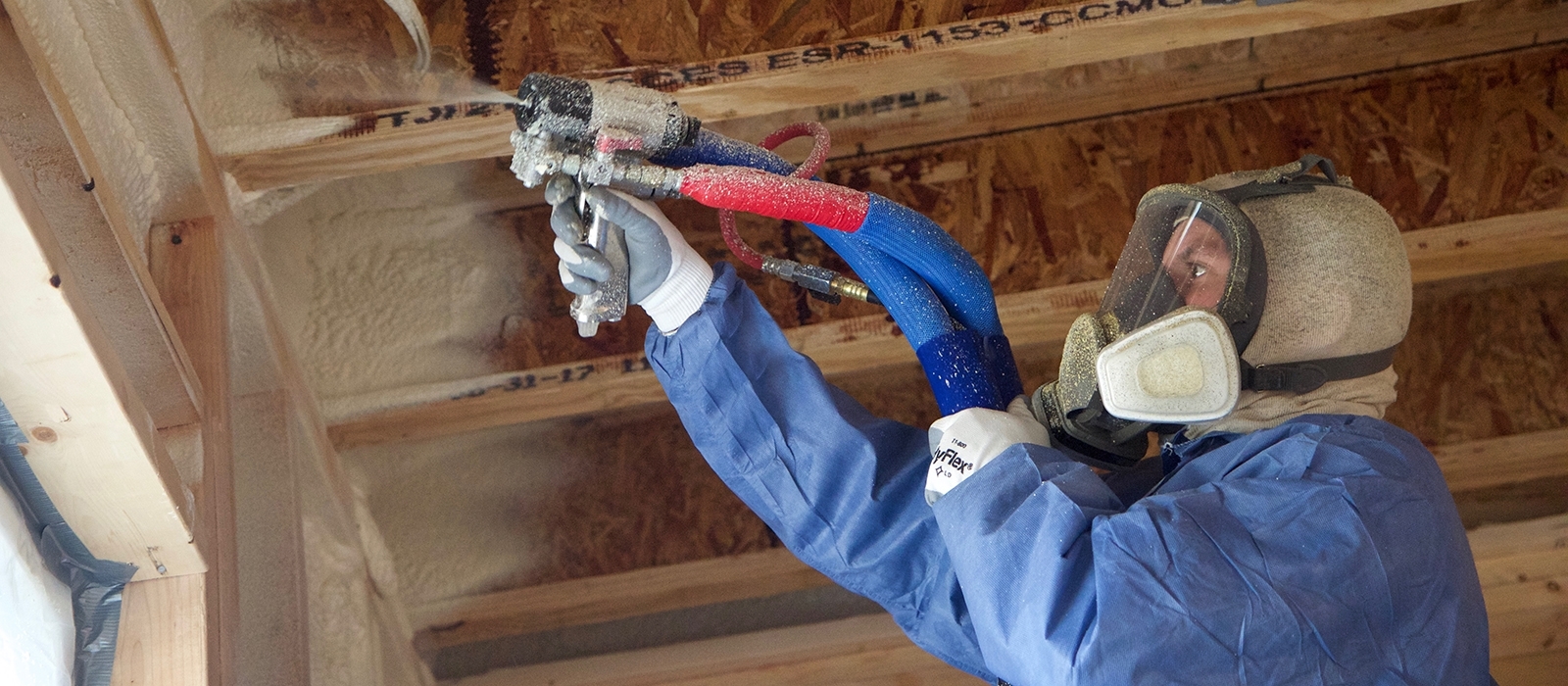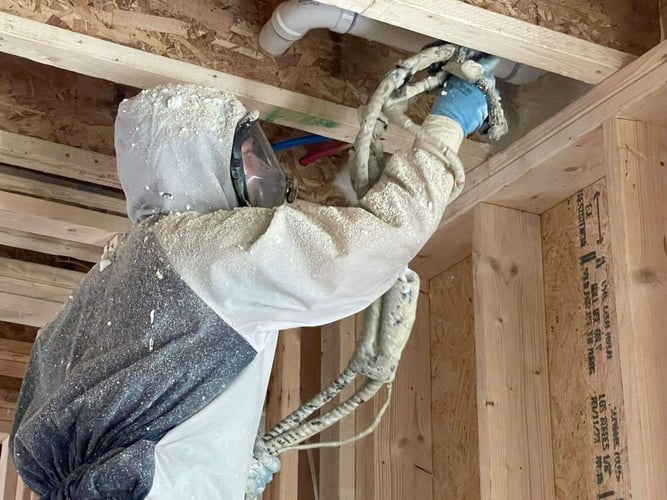Frequently Asked Questions Regarding Spray Foam Installation and Usage
Frequently Asked Questions Regarding Spray Foam Installation and Usage
Blog Article
Spray Foam: The Ultimate Remedy for Air Sealing and Insulation
Spray foam insulation has emerged as a leading solution for effective air securing and thermal insulation, providing an unique combination of residential or commercial properties that set it besides traditional approaches. Its capability to increase and load spaces makes it especially efficient in stopping air leak, which can dramatically impact energy performance. Recognizing the full extent of its advantages, setup processes, and comparisons with other insulation kinds is critical for making informed decisions. As we discover these elements, the ramifications for both new building and constructions and retrofits become significantly considerable. What aspects should affect your choice?
What Is Spray Foam?
Spray foam is a flexible insulation material that combines the concepts of air securing and thermal resistance to improve energy effectiveness in structures. Made up largely of polyurethane or various other similar substances, spray foam is applied as a fluid that expands upon contact with surface areas, creating a strong, continual layer of insulation. This special home permits it to fill up voids, fractures, and spaces that conventional insulation materials might neglect, offering an exceptional air seal.
There are two main kinds of spray foam: open-cell and closed-cell. Open-cell spray foam is lighter and much more adaptable, using outstanding audio absorption and a reduced R-value per inch - Spray Foam. On the other hand, closed-cell spray foam is denser, providing a greater R-value, wetness resistance, and added architectural stability to constructing components
The application procedure commonly entails specialized tools, making sure a seamless application that follows numerous substratums, including timber, concrete, and steel. This adaptability makes spray foam appropriate for both brand-new buildings and retrofitting existing structures. Its capacity to produce an airtight barrier considerably contributes to reducing energy consumption and boosting indoor air high quality, thereby making it a recommended choice among homeowners and contractors alike.
Advantages of Spray Foam Insulation
Among one of the most considerable benefits of spray foam insulation is its remarkable ability to create a continuous air barrier, which efficiently decreases power loss. Unlike traditional insulation products, spray foam increases to load cracks and voids, making certain that air leakage is substantially minimized. This characteristic not just enhances power effectiveness but additionally results in decrease energy costs in time.
Furthermore, spray foam insulation gives remarkable thermal resistance, adding to a much more stable indoor setting. Its high R-value per inch permits reliable insulation in restricted rooms, making it suitable for attics, wall surfaces, and crawl areas. Furthermore, the moisture-resistant homes of spray foam assistance protect against mold and mildew development, advertising healthier living conditions.
Another critical benefit of spray foam insulation is its sound-dampening qualities (Spray Foam). It successfully reduces sound transmission between areas, creating a quieter and much more comfy home atmosphere. The durability of spray foam likewise stands apart, as it does not droop or clear up gradually, preserving its efficiency throughout its lifespan
Just How Spray Foam Functions
Recognizing exactly how spray foam insulation works is vital for appreciating its performance in air securing and thermal resistance. Spray foam insulation includes 2 key components: isocyanate and polyol resin. When these components are mixed, they undergo a chain reaction that causes the material to expand rapidly, creating a thick foam that loads cracks, gaps, and tooth cavities.
As the foam expands, it sticks to surfaces, forming an airtight seal that significantly lowers air infiltration. This characteristic makes spray foam insulation very reliable at protecting against drafts and dampness penetration, which can cause energy loss and damage over time. Furthermore, the closed-cell variation of spray foam offers superior thermal resistance as a result of its stiff structure, effectively decreasing warm transfer.
The distinct residential or commercial properties of spray foam allow it to comply with uneven surface areas, making sure comprehensive insurance coverage and a smooth obstacle. Consequently, spray foam insulation not only improves energy performance however additionally adds to improved interior air top quality by lowering the buildup of irritants and contaminants. Eventually, understanding the mechanics behind spray foam highlights its function as an exceptional selection for insulation and air securing in both commercial and domestic applications.
Setup Process Introduction

Before installment, the room must be appropriately cleaned and prepped, guaranteeing that surface areas are cost-free from dampness, dust, and debris. This step is critical due to the fact that contaminants can compromise adhesion and overall efficiency. Once the area is prepared, the application involves blending the 2 parts of the spray foam, Click This Link which increases upon call and fills up spaces successfully.
Educated experts must carry out the setup, using specific devices to guarantee uniform coverage and optimal thickness. Safety precautions, including wearing protective equipment and ensuring correct air flow, are crucial throughout this procedure. After application, the foam typically remedies swiftly, developing a solid barrier that improves power efficiency.
Comparing Spray Foam to Standard Insulation
When evaluating insulation options, spray foam insulation sticks out in comparison to standard materials such as fiberglass and cellulose. One of the primary benefits of spray foam is its exceptional air sealing capabilities. Unlike fiberglass and cellulose, which can allow air infiltration, spray foam broadens upon application, filling up crevices and gaps to develop an impermeable seal. This leads to improved energy efficiency, as much less warmed or cooled down air runs away the home, leading to lower energy bills.
Additionally, spray foam supplies a higher R-value per inch than standard insulation types, supplying more efficient thermal resistance in a thinner account. This particular is specifically helpful precede with limited cavity depth. Moreover, spray foam is immune to dampness and mold and mildew growth, which can be a significant worry about cellulose and fiberglass, specifically in moist environments.
Nevertheless, spray foam insulation normally brings a you could try this out greater in advance expense than its conventional equivalents. House owners need to evaluate this preliminary investment against long-lasting energy savings and performance benefits. Ultimately, while both insulation types serve their objective, spray foam arises as an extra advanced remedy for modern-day insulation requirements, especially in terms of air securing and thermal performance.

Conclusion
In summary, spray foam insulation stands for a very effective service for attaining optimal air sealing and thermal resistance. Its special residential or view website commercial properties, consisting of moisture resistance and noise dampening, make it ideal for various applications in both new building and constructions and retrofitting tasks (Spray Foam). The first costs may be higher compared to traditional insulation materials, the long-term advantages, such as significant energy savings and improved indoor air top quality, warrant the financial investment and highlight its value in modern building techniques.
Spray foam insulation has actually arised as a leading option for efficient air sealing and thermal insulation, offering a distinct combination of homes that set it apart from traditional methods.Spray foam is a functional insulation product that integrates the principles of air sealing and thermal resistance to boost power effectiveness in buildings.When evaluating insulation options, spray foam insulation stands out in contrast to conventional materials such as fiberglass and cellulose. Inevitably, while both insulation types serve their objective, spray foam emerges as a more innovative option for contemporary insulation requirements, especially in terms of air sealing and thermal efficiency.
In summary, spray foam insulation stands for a highly effective service for attaining optimal air sealing and thermal resistance.
Report this page